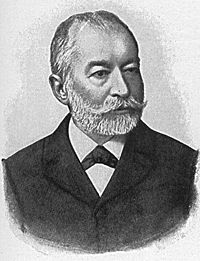
Dimitrie Sturdza
Encyclopedia

Romania
Romania is a country located at the crossroads of Central and Southeastern Europe, on the Lower Danube, within and outside the Carpathian arch, bordering on the Black Sea...
n statesman of the late 19th century, and president of the Romanian Academy
Romanian Academy
The Romanian Academy is a cultural forum founded in Bucharest, Romania, in 1866. It covers the scientific, artistic and literary domains. The academy has 181 acting members who are elected for life....
between 1882 and 1884.
Biography
Born in IaşiIasi
Iași is the second most populous city and a municipality in Romania. Located in the historical Moldavia region, Iași has traditionally been one of the leading centres of Romanian social, cultural, academic and artistic life...
, Moldavia, and educated there at the Academia Mihăileană
Academia Mihaileana
Academia Mihăileană was an institution of higher learning based in Iași, Moldavia, and active in the first part of the 19th century. Like other Eastern Europeean institutions of its kind, it was both a high school and a higher learning institute, housing several faculties.-History:Academia...
, he continued his studies in Germany
German Confederation
The German Confederation was the loose association of Central European states created by the Congress of Vienna in 1815 to coordinate the economies of separate German-speaking countries. It acted as a buffer between the powerful states of Austria and Prussia...
, took part in the political movements of the time, and was private secretary to Prince
Domnitor
Domnitor was the official title of the ruler of the United Principalities of Wallachia and Moldavia between 1859 and 1866....
Alexander John Cuza
Alexander John Cuza
Alexander John Cuza was a Moldavian-born Romanian politician who ruled as the first Domnitor of the United Principalities of Moldavia and Wallachia between 1859 and 1866.-Early life:...
. Sturdza afterwards turned against the increasingly unsanctioned rule of Cuza, and joined Ion Brătianu
Ion Bratianu
Ion C. Brătianu was one of the major political figures of 19th century Romania. He was the younger brother of Dimitrie, as well as the father of Ionel, Dinu, and Vintilă Brătianu...
and others in the deposition of the Prince (1866), becoming a member of the Liberal government.
In 1899 he was elected leader of the National Liberal Party
National Liberal Party (Romania)
The National Liberal Party , abbreviated to PNL, is a centre-right liberal party in Romania. It is the third-largest party in the Romanian Parliament, with 53 seats in the Chamber of Deputies and 22 in the Senate: behind the centre-right Democratic Liberal Party and the centre-left Social...
in succession to Brătianu, and was four times Prime Minister - for his last time in office, in 1907, Sturdza was called by King
King of Romania
King of the Romanians , rather than King of Romania , was the official title of the ruler of the Kingdom of Romania from 1881 until 1947, when Romania was proclaimed a republic....
Carol I
Carol I of Romania
Carol I , born Prince Karl of Hohenzollern-Sigmaringen was reigning prince and then King of Romania from 1866 to 1914. He was elected prince of Romania on 20 April 1866 following the overthrow of Alexandru Ioan Cuza by a palace coup...
to handle the crisis created by the peasants' revolt of March
1907 Romanian Peasants' Revolt
The 1907 Romanian Peasants' Revolt took place in March 1907 in Moldavia and it quickly spread, reaching Wallachia. The main cause was the discontent of the peasants about the inequity of land ownership, which was in the hands of just a few large landowners....
.
Although noted for his capacity for work, he was also a nationalist
Nationalism
Nationalism is a political ideology that involves a strong identification of a group of individuals with a political entity defined in national terms, i.e. a nation. In the 'modernist' image of the nation, it is nationalism that creates national identity. There are various definitions for what...
, resentful of "aliens" (in line with the anti-Jewish policies of his party), and supported blocking non-Romanians from a large number of social positions.
He was appointed permanent secretary of the Romanian Academy, and became a recognized authority on Romanian numismatics
Numismatics
Numismatics is the study or collection of currency, including coins, tokens, paper money, and related objects. While numismatists are often characterized as students or collectors of coins, the discipline also includes the broader study of money and other payment media used to resolve debts and the...
. As secretary of the academy he was instrumental in assisting the publication of the collections of historic documents made by Constantin Hurmuzachi (30 vols., Bucharest
Bucharest
Bucharest is the capital municipality, cultural, industrial, and financial centre of Romania. It is the largest city in Romania, located in the southeast of the country, at , and lies on the banks of the Dâmbovița River....
, 1876-1897), and other acts and documents besides a number of minor political pamphlets of transitory value.
His son Alexandru Sturdza, by then a Colonel in the Romanian Army, defected to the Germans
German Empire
The German Empire refers to Germany during the "Second Reich" period from the unification of Germany and proclamation of Wilhelm I as German Emperor on 18 January 1871, to 1918, when it became a federal republic after defeat in World War I and the abdication of the Emperor, Wilhelm II.The German...
in 1916, during the World War I
Romanian Campaign (World War I)
The Romanian Campaign was part of the Balkan theatre of World War I, with Romania and Russia allied against the armies of the Central Powers. Fighting took place from August 1916 to December 1917, across most of present-day Romania, including Transylvania, which was part of the Austro-Hungarian...
.
See also
- Sturdza familySturdza familySturdza, Sturza or Stourdza is the name of an old Romanian family, whose origins can be traced back to the 1540s.The Sturdza family has been long and intimately associated with the government first of Moldavia and afterwards of Romania...

